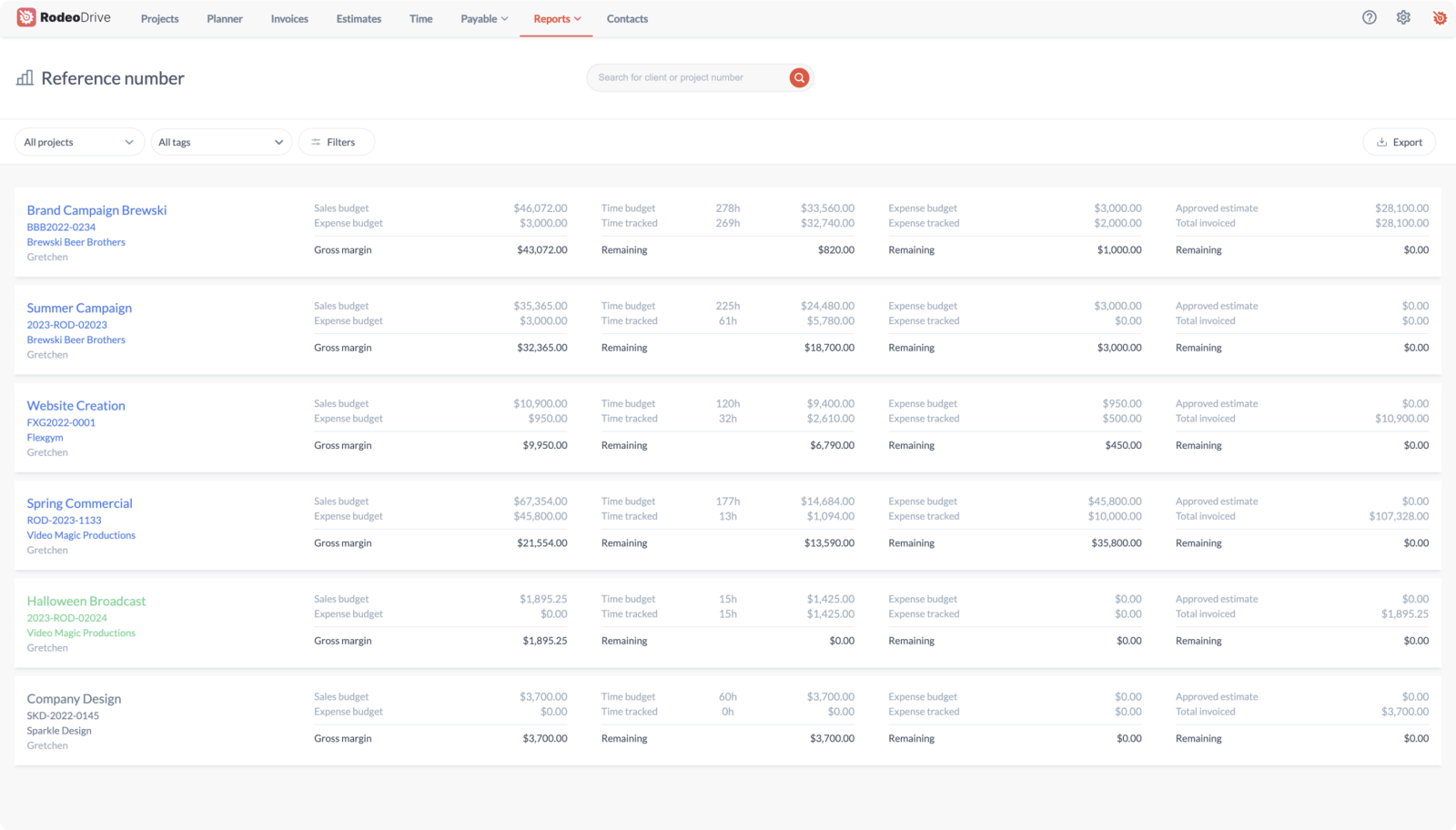Best Practices for Benchmarking in Project Management
Simply put, project management benchmarking is when you compare your project performance to similar projects — either past projects of your own or others in the industry — to see how well your project team is doing.
That said, you shouldn’t take a one-size-fits-all approach to benchmarking. Instead, you want to take an approach that best meets your needs based on your industry, project scope, and size.
In this blog, we’ll break down everything you should know about the various approaches to benchmarking in project management, complete with examples and common mistakes to be aware of.
What is benchmarking in project management?
Benchmarking is a strategy that helps project managers identify whether their team is meeting performance expectations.
In project management, benchmarking involves identifying relevant metrics that signify team performance, collecting data (and reporting) on those metrics as your project progresses, and then comparing your results against similar internal projects, competitors, or industry standards. This way, you can gauge how successful your team has been compared to other projects within your organization or competitors.
The idea is that by comparing your data against outside sources, you’re able to better identify how your team’s performance can be improved and change your existing processes and methods accordingly.

Why is benchmarking important?
Without collecting the right metrics, how can you be sure that your team is performing as expected? This is just one reason why benchmarking is an important part of project management. Other reasons include:
- Helps keep your team accountable for a strong project execution.
- Allows you to better assess weaknesses in your workflows that are leading to project management performance results that are below expectations.
- Makes it easier to identify how company-wide changes to things like onboarding or training processes have had an impact on project success.
- Ensures your organization is producing results that are in line with your competition, thus potentially reducing churn and improving client satisfaction.
Most common approaches to benchmarking in project management
There are quite a few different approaches to benchmarking at your disposal. Before deciding on which one your team should use, first consider what you’re trying to measure.
For instance, if your goal is to improve company-wide consistency in project performance, you might want to opt for internal benchmarking. But, if you’re primarily focused on keeping up with market trends, you may want to consider competitive benchmarking instead.
Here’s an overview of some of the most common benchmarking techniques to help you decide which is best for your team:
Internal benchmarking
Internal benchmarking is when you set company-wide standards to measure the success of internal projects.

By comparing your project results against the results of other projects organized by your company, you can determine how your team measures up within your organization. Seasoned project managers might also practice benchmarking against their own past projects that are similar in size and scope.
External benchmarking
This type of benchmarking in project management is when you use external data sources to analyze the performance of your projects. By relying on an outside data source, you’ll have a better understanding of how your team’s project results compare to similar projects in the field.
The main barrier to external benchmarking is that data on projects outside of your organization isn’t always accessible. For this reason, many organizations find that they need to rely on third-party consultants to help with their external benchmarking.
Another way to do so is by joining an industry benchmarking consortium, which is a group of companies in the same industry that come together and confidentially share their data, which can be used for overall benchmarking standards.

Competitive benchmarking
Competitive benchmarking is centered around comparing your projects to competitors or industry standards. By ensuring that your team is meeting performance goals based on industry metrics, your client or stakeholders can feel confident that your project is of top-notch quality.
Although external benchmarking also utilizes outside data, information for competitive benchmarking is different because it typically relies on insights like market trends, competitor pricing, customer reviews, and market share.
Some of this information is already readily available online, but you might need to conduct market surveys for other details. Some organizations hire consultants to help collect the right information for this type of benchmarking.
Web-based benchmarking
Using this approach, project managers rely on a web-based interface managed by a third party to determine how their performance compares to competitors and industry standards.
Instead of placing the responsibility of benchmarking on a project manager, the web-based method makes this third party entirely responsible for tracking and managing the benchmarking process on behalf of your team.
Web-based benchmarking might not be a good fit for all industries. That said, it’s an especially popular benchmarking approach in the construction industry.
Project Management Maturity Model (PMMM)
Project Management Maturity Models seek to measure your organization’s level of receptivity to project management. PMMM does this using a rating system that gauges your team’s implementation of project management processes and practices — including project management skills.
This approach is helpful in determining how well your team or organization has adjusted to the adoption of new project management strategies, although it falls short in measuring performance metrics for a particular project.
As such, PMMM can be a good way of assessing how your organization has improved its implementation of project management strategies over time. But if you’re looking for a benchmarking technique that examines the nitty-gritty of your project performance, you’ll probably want to opt for a different approach.
Identifying the right performance metrics for project management benchmarking
Now that we’ve covered the different methods for benchmarking, you’re probably wondering what performance metrics or data are typically used to compare project performance.
Below, you’ll find the most common calculations that yield relevant insights on project performance. This list is by no means exhaustive, as other performance metrics might include: budget performance, client satisfaction, number of scope changes, project cost, and the number of projects completed.
All in all, any numerical metrics that measure team performance can be used in your benchmarking to some degree.
Related: Performance Reporting Tools for Project Management
Project cost variance
Project cost variance is just one method you can use to track your project’s financial performance. By subtracting the amount you actually spent on the project from the amount you budgeted for, you’ll be able to glean whether your project was within budget or if you went over.

Also read: 50 Important Project Management Terms You Need to Know
Return on investment (ROI)
Your project ROI represents the profit you make from your project after you’ve accounted for all of your costs. You might think of your ROI as a determination of whether a project is worth taking on.
To calculate ROI, divide your net benefits (which is the financial value of the project minus its costs) by your project cost, and then multiply by 100.

Time to Market (TTM)
Your TTM measures the length of time it takes to go from product conception to launch and distribution. This is a useful metric for measuring your team’s ability to stick to expectations regarding the project timeline.
Because TTM is a length of time, there isn’t a formula to follow. That said, in most industries, TTM is measured in months.
Cost Performance Index (CPI)
The cost performance index is somewhat similar to your project cost variance, as it determines how your project performs against its budget. This, in turn, can help you improve your project budgeting approach in future projects.
To calculate CPI, you’ll first need to determine your earned project value, which is your percentage of completed tasks multiplied by your project budget. Once you’ve calculated this number, divide it by your actual project costs to get your CPI.

Examples of benchmarking in project management
Project management can be used in dozens of different industries to keep company initiatives organized and on track for success. As such, project benchmarking is a valuable strategy for teams in many different fields.
If you’re still unsure what benchmarking in project management looks like in practice, here are a few industry-specific examples.
Construction project management benchmarking
If you run a construction company that’s building a new office building, you might want to benchmark your project against a different office building of the same size in the same neighborhood that was completed by a competing construction company.
To do this, you’ll want to examine a variety of different things. What was the Time to Market (TTM) for each project? How did your project cost variance square up against theirs? How many safety incidents were reported during each project? How does the quality of the two buildings compare?
Software development project management benchmarking
If your software development team is building a new mobile app, you may want to benchmark your project team’s progress against a competing app with a similar value proposition.
Your benchmarking might include a look at industry trends on how the two apps’ features track with market demands and trends, and how customer satisfaction differs between the two platforms. Comparing customer data might illuminate areas where your development team’s performance fell short and is contributing to a negative user experience, for instance.
Marketing project management benchmarking
Marketing teams often use project management practices to manage their marketing campaigns, including benchmarking. And because many marketing campaigns often happen on a quarterly basis — such as an annual fourth quarter push to prepare for the holiday rush — internal benchmarking can be helpful to monitor performance year over year.
For example, a marketing project manager might look at how audience engagement, ROI, and conversion rates compared to the previous year and assess how team performance may have contributed to either a growth or decline.
Common mistakes to avoid when benchmarking for project management
Benchmarking is an important part of goal-setting in project management, but it can be challenging — especially for project teams who’ve never done it before. Here are three common project management benchmarking challenges you’ll want to look out for:
#1 Relying on outdated data
The world today is rapidly changing, so much so that it can be difficult for data to keep up.
Take the COVID-19 pandemic as just one example. If you find yourself benchmarking against industry data that was collected prior to 2020, you should consider the ways that this data might be outdated and no longer useful. Consumer attitudes, habits, and economic conditions have all dramatically changed in the last three years, which is certainly something you should evaluate.
More recently, Chat GPT has dramatically changed market trends and the feature offerings of many products — all in the last year. Teams practicing competitive benchmarking can accidentally rely on data that is too old to accurately depict industry trends like this, which is certainly something to look out for.
#2 Disregarding external factors that may impact your project performance
Let’s say you’re looking at your internal benchmarks and are wondering why your current project isn’t seeing the type of success that one of your past projects had, even though the two are very similar. Might this be because of an external factor — such as an economic recession — that’s making it more difficult for your project to find success?
Project benchmarking should not be done in a vacuum. It’s crucial that you consider external factors that might be impacting your project before drawing conclusions on the reasons for your project’s unexpected performance.
#3 Comparing projects or data with different sizes and scopes
One of the most common mistakes with project benchmarking is comparing projects that are different in size or scope. Doing so is counterproductive, as projects with differing budgets and objectives are almost sure to yield different results.
Instead, you need to set benchmarks based on very similar projects or exact competitor data. Otherwise, you’ll find that the learnings you derive from project management benchmarking aren’t helpful enough to justify the time you’ve invested.
Related: 13 Best Practices for Successful Change Management
Allow Rodeo Drive to take the guesswork out of your projects
Improving the predictability of project outcomes is a key goal of almost every project manager. Luckily, implementing a project management tool can help you do just that.
Rodeo Drive is a comprehensive project management solution that can help you streamline your workflows and provide a centralized place for all of your project information. This means you won’t need to rely on costly and annoying third-party integrations to manage your projects from start to finish.
With budgeting, time tracking, task planning, invoicing, and reporting all in one app, you’ll have easy access to your team’s project data — making it easier to compare your team’s performance against your benchmarks.
But don’t just take our word for it — sign up for free and come see Rodeo Drive for yourself.







